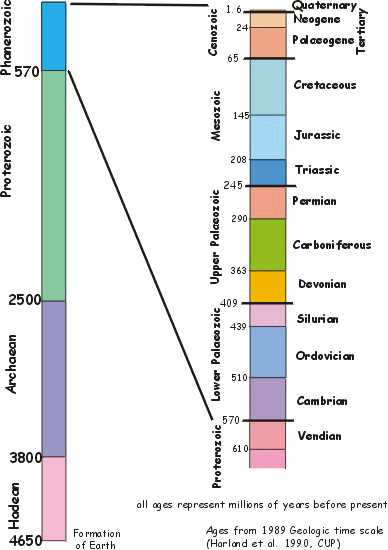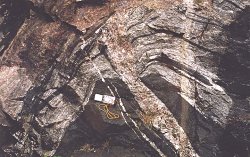

In almost all understanding of geological processes it is impossible to divorce the issue of time. And fundamental to understanding time in the geological record is the idea that the geometric relationships between rocks betray the sequence of geological processes that formed (and deformed) them. Building up a relative geological time scale is a fundamental skill.
The diagram below gives you a few tools of the trade. Click on it to view the animation.
 There
is also an accepted Geologic Timescale, originally based on the fossil content of sedimentary rocks
but calibrated (and extended into unfossiliferous sequences) using radiometric dating. A current version
is displayed to the left.
There
is also an accepted Geologic Timescale, originally based on the fossil content of sedimentary rocks
but calibrated (and extended into unfossiliferous sequences) using radiometric dating. A current version
is displayed to the left.
 A
key to understanding rock sequences and dividing them into managable packages is the recognition of unconformities.
In their simplest form these represent breaks or time-gaps in the geological record at a particular
location. One bed may overlie another but the boundary between represents a period of time (sometimes
many tens of millions of years) when no rocks were deposited.
A
key to understanding rock sequences and dividing them into managable packages is the recognition of unconformities.
In their simplest form these represent breaks or time-gaps in the geological record at a particular
location. One bed may overlie another but the boundary between represents a period of time (sometimes
many tens of millions of years) when no rocks were deposited.  Alternatively
rocks may have been deposited and then eroded away before the younger series were deposited. In general
it can be quite tricky recognising these forms of unconformity. But in other situations an older series
of rocks might be deposited, deformed and then eroded so that the younger rocks overlie strata that
are not parallel to them. This is termed an angular unconformity and is much easier
to spot. Another pattern can be found when older rocks are folded or tilted and then the younger strata
simply bank in filling the lower-lying areas first then gradually burying the rest.
Alternatively
rocks may have been deposited and then eroded away before the younger series were deposited. In general
it can be quite tricky recognising these forms of unconformity. But in other situations an older series
of rocks might be deposited, deformed and then eroded so that the younger rocks overlie strata that
are not parallel to them. This is termed an angular unconformity and is much easier
to spot. Another pattern can be found when older rocks are folded or tilted and then the younger strata
simply bank in filling the lower-lying areas first then gradually burying the rest.  The
younger strata are said to onlap the older. Another way of recognising unconformities
is when sediments have depositional contacts with underlying rocks that weren't formed at the Earth's
surface, such as metamorphics or intrusive igneous rocks.
The
younger strata are said to onlap the older. Another way of recognising unconformities
is when sediments have depositional contacts with underlying rocks that weren't formed at the Earth's
surface, such as metamorphics or intrusive igneous rocks.